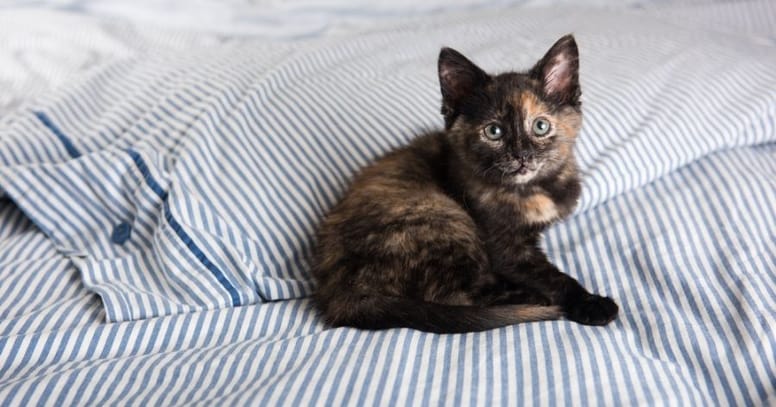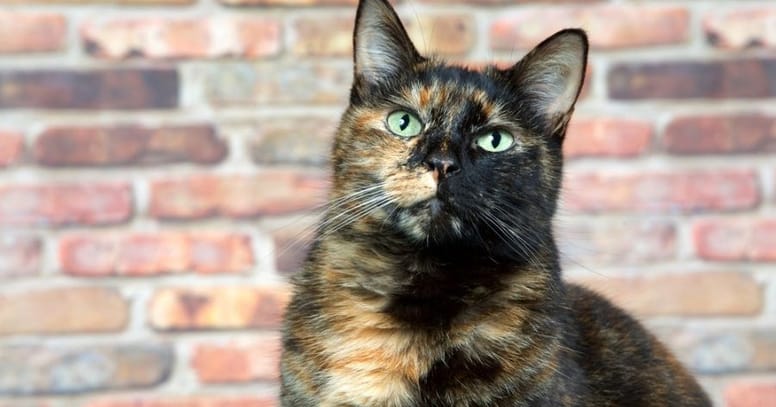Tortoiseshell cat. This term refers to the coat of the cat, which has several colours: black and red, with occasional white spots, but very few. A tortoiseshell coat that has a large amount of white spots is called a calico coat, a variant of tortoiseshell. The term "tortoiseshell" refers to a coat, it is not a cat breed in its own right like the Spynhx or the Persian.
The tortoiseshell cat is the subject of several superstitions and theories, such as the fact that it has a strong personality or that it brings good luck. So is all of this true? What is the origin of the tortoiseshell cat? Do you want to know everything about this beautiful and unique cat? Here we go! And surprise, we’ve hid a few fun facts in this article, will you find them all?
How can I recognise a tortoiseshell cat?
The term tortoiseshell cat refers to a cat’s coat. It is a mix of black and red, more or less diluted. Their eyes can range from yellow to green to orange.

The patterns of the tortoiseshell
The tortoiseshell coat will be more or less easy to determine depending on the pattern. Indeed, the tortoiseshell cat can have a spotted, speckled or swirled coat. The size of the patterns can vary, making them sometimes blurred, blended and therefore difficult to determine!
The different variations of a tortoiseshell cat
In cats, as in many animals, there is a so-called dilution gene. This gene has the ability to lighten the coat colour of some animals, thus increasing the possible variations. The coat of the diluted tortoiseshell cat will tend to become lighter. Thus, it may tend towards "chocolate" and "cinnamon" colours. Sometimes the black can be so diluted that we speak of a grey or even blue tortoiseshell cat.
As you might know, there are several variations of the tortoiseshell cat. For example, the calico is a black and red coat with a relatively large number of white spots. A torbie cat is the mix between a tortie or calico cat and the markings of a tabby cat. The variations of the tortoiseshell cat's coat are endless and unique.
Fun Fact 1: Have you just adopted a tortoiseshell kitten? Great news, your kitten will keep its coat colour for the rest of its life.
Which cat breeds can have this coat colour?
The tortoiseshell coat can be seen in both alley cats and pedigree cats. It can be found in many breeds, both long haired and short haired, such as the Maine Coon, the Turkish Angora, the Persian and the European cat. There is no one breed that is more or less predestined to having a tortoiseshell coat.
Origin and history of the tortoiseshell cat
With a coat as original as its name, one might wonder where the tortoiseshell cat came from. So what's the origin of the tortoiseshell cat?
As you can see, the term "tortoiseshell cat" comes from the black and red colours, which look like the exotic colours of some green turtles.
Fun Fact 2: No meaning or superstition behind this name. However, some people believe that tortoiseshell cats bring good luck. The Americans call them "money cats", although it is not clear why. This superstition probably stems from the rarity of the tortoiseshell cat or from the link between the tortoise and luck in Asian culture. In Japan, tortoiseshell cats were apparently even carried on ships to protect against ghosts and evil spirits. Believe it or not.
The tortoiseshell cat owes nothing to chance. To understand why it is so uncommon, we need to look closely at its genetics. A cat has 19 pairs of chromosomes, compared to 23 in humans. For each pair, half is transmitted by the mother and half by the father. In cats, and in humans, the sex chromosomes are XX for a female and XY for a male. It is these sex chromosomes that determine the colour of the cat's coat. To obtain a tortoiseshell cat you need an orange and a black gene. Without going into detail, the two genes that give the black and red colour are only present in the X chromosome. A tortoiseshell cat is black and ginger, so its sex chromosomes must be XX. Hence the legend that tortoiseshell cats are only females! But this is not totally true, because there is always the exception that proves the rule…
Fun Fact 3: Is it true that there is no such thing as a male tortoiseshell cat? No, it is not true. There are not "many" male tortoiseshell cats, since 99,9% are females, but they do exist! Indeed, as seen above, pure genetics would like it to be no male tortoiseshell cat. However, this happens about 1 time out of 3000. It would simply be an anomaly that would bring 3 XXY chromosomes to the cat. This is called Klinefelter's syndrome.

Fun Fact 4: Are male tortoiseshell cats sterile? Again, this is not 100% true. Even if it is true that almost all male tortoiseshell cats are sterile, there are exceptions! Klinefelter's syndrome, which gives a male cat 3 XXY chromosomes instead of 2 XY chromosomes, does indeed cause a disorder in the reproductive system. However, recent studies have shown that this is not always the case. Genetic, a male tortoiseshell cat is a perfect example of this since he had no reproductive problems, according to a veterinarian at the SPA Mauricie in Quebec.
The personality of a tortoiseshell cat: Are tortoiseshell cats friendly?
The particular temperament of tortoiseshell cats is perhaps due more than anything else to the fact that they are females; indeed, they tend to be more independent than males and often less demonstrative. More discreet, they are also more exclusive, so tortoiseshells are often the cat of one owner only. For this reason they are called aloof and this is not justified, as female cats are simply more reserved as a general rule.
Moreover, exceptions to this rule are not uncommon and, as with all cats, personality of course depends on the individual and not on the coat colour! As tortoiseshells are not a breed, but just a coat colour, it is wrong to make a generalisation. On the contrary, happy owners of tortoiseshell cats describe them as cuddly and mischievous, and indeed sometimes shy, especially with strangers and people outside their family. They are above all devoted companions for those who know how to tame them with tact and patience... Don't we say that it is the cat who chooses its owner and not the other way round? So if a tortoiseshell crosses your path, there is a good chance that it is made for you!
How long do tortie cats live?
Again, as tortoiseshell cats do not denote a particular breed, their longevity can vary. If you know that your tortoiseshell belongs to a specific breed, such as the American Shorthair or Cornish Rex, then look at the longevity of that specific cat breed.
If you're not sure, you can look at the average lifespan of a feline to determine that of a tortoiseshell. According to a British study that examined the longevity and mortality of over 100,000 cats, the average life span is 14 years. Crossbred and mixed breed cats live longer though.
Is a tortoiseshell cat rare?

Remember what we said just above? Tortoiseshell cats are more than 99% of the time... female cats! Indeed, this specific coat is in fact linked to a very rare gene in male cats. Although it can happen that a male cat is born with a tortoiseshell or tricolour coat, this happens only 1 time out of 3000. And when this happens, the cat is usually sterile: for more complex genetic reasons, the tortoiseshell gene only appears in the male when he has 3 XXY combination chromosomes. Males usually are sterile and therefore cannot breed with tortoiseshell females, so this coat is considered rare and somewhat random.
What's a good name for a tortoiseshell cat?
Choosing your new cat's name is probably one of the most difficult tasks because you know how special and unique your feline is and you want to find a name that will suit your cat. So have you just adopted a tortoiseshell cat and are looking for the perfect name? Check out this list we’ve prepared for you. And yes, although 99% of tortoiseshell cats are female, we’ve still added a few male cat names because who knows you might be the lucky owner of a male tortoiseshell cat.
- Amy
- Alex
- Apricot
- Auburn
- Autumn
- Blaze
- Brownie
- Caramel
- Daisy
- Dotie
- Fiona
- Ginger
- Hazel
- Iris
- Maple
- Mocha
- Peach
- Pepper
- Robyn
- Rosie
- Ruby
- Tessa
- Tortie
- Zinnie
- Zoe
Wait a second? We can’t leave you without one last fun fact about the tortoiseshell cat! So here it is.
Fun fact 5: The Tortoiseshell cat has an impressive resume. Indeed, it’s not just their looks, personality or mystic powers that make these felines extremely special. One tortie for example was a muse for the poet Edgar Allan Poe. Also, one tortie worked as a station master in Japan and another, named Marzipan, lived until the impressive age of 21, in Australia, he became Astor Theatre’s resident feline and was famous because he would snuggle in during shows to look for cuddles. Last by not least, the state of Maryland made the tortoiseshell cat their official cat and a state symbol. Not bad!



